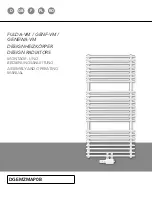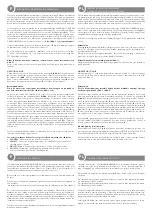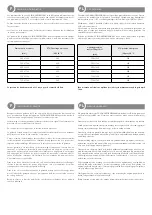
Bei der Montage von Heizkörpern ist zu beachten, dass die Befestigung von Heizkör-
pern so dimensioniert wird, dass sie für die bestimmungsgemäße Verwendung und
vorhersehbarer Fehlanwendung geeignet ist. Hierbei sind insbesondere die Verbin-
dung mit dem Baukörper sowie dessen Beschaffenheit, die Geeignetheit des Mon-
tagezubehöres und die möglichen Belastungen nach erfolgter Montage zu prüfen.
Die Installation und Inbetriebnahme Ihres Designheizkörpers FULDA-VM/GENF-VM
ist von einer zugelassenen Fachfirma durchzuführen. Bei der Installation sind die ein-
schlägigen Normen bzw. die nationalen elektrotechnischen Sicherheitsvorschriften
wie ÖVE- und VDE-Bestimmungen zu beachten.
Unter Berücksichtigung der geometrischen Maße des Designheizkörpers FULDA-VM/
GENF-VM und der Anschlussarmatur ist die Verrohrung vorzubereiten
(siehe Abb. 1
bzw. Abb 3).
Wir empfehlen einen seitlichen Mindestabstand zum Heizkörper von 100 mm einzu-
halten. Dabei ist Nachfolgendes zu berücksichtigen.
Wird ein Elektroheizelement verwendet, kann dieses in eine der beiden 1/2“ Muf-
fen
I
eingedichtet werden. Dabei sind die Hinweise der Montageanleitung für das
PTC-Elektroheizelement zu beachten.
Vor der Wandmontage des Heizkörpers ist zu beachten (siehe Abb. 3):
Der Vorlaufanschluss befindet sich links von der Mitte des Designheizkörpers.
WANDMONTAGE:
Aufstecken der beigepackten Blechmuttern
1
auf die Montagestutzen
2 (Abb. 2)
.
Anreißen, bohren der Löcher Position
A
- Bohrer ø10 - und setzen der Dübel entspre-
chend den Aufhängungsmaßen -
(Abb. 1)
. Für eine sehr solide Wandmontage wird
empfohlen, auch die Wandfüße Position
B
an die Wand zu schrauben. Erfolgt dies
nicht, dann dienen die Wandfüße Position
B
als Distanzierungen.
Empfehlung:
Messen Sie bitte vorher zur Heizkörperidentifizierung die Abstandsmaße der
Montagestutzen 2 (Abb. 1 u. Abb. 2) nach.
Nach Bedarf (Wandbeschaffenheit) sind die beigepackten Kunststoffbeilagen
3
auf
die Wandfüße
4
zu kleben
(Abb. 2)
. Bitte auf saubere Klebestellen achten.
Befestigung der oberen und eventuell unteren Wandfüße
4
und diese waagrecht
bzw. senkrecht ausrichten, wobei die Senklochbohrungen
5
in den Wandfüßen nach
außen stehen müssen. Dabei sollen die Wandmontageschrauben
6
in der Mitte der
Langlöcher der Wandfüße montiert werden. (Es wird empfohlen, die Abstandsmaße
der montierten Wandfüße vor der Heizkörperwandmontage zu kontrollieren.) Falls
die unteren Wandfüße
B
als Distanzierung verwendet werden, sind diese auf die Mon-
tagestutzen
2
zu stecken und mit den Blechschrauben
7
zu befestigen.
Wandmontage des Heizkörpers, indem die oberen Montagestutzen
2
(eventuell auch
unteren Montagestutzen) in die Wandfüße
A
- eventuell auch
B
gesteckt und mittels
Blechschraube
7
miteinander verbunden werden. Durch das Langloch im Montage-
stutzen kann der Wandabstand variiert werden.
Verstellmöglichkeiten in Baulängen- bzw. Bauhöhenrichtung sind durch das Langloch
in der beweglichen Scheibe
8
im Wandfuß gegeben, sollten die hydraulischen An-
schlüsse nicht genau passen.
Für den hydraulischen Anschluss verwenden Sie bitte die beigepackte Anschluss-
armatur und beachten Sie die entsprechende Montageanleitung.
Folgende Normen sind bei der Montage der Heizkörper unbedingt einzuhalten:
•
DIN 55900:
Sprühbereich in Nassräumen
•
VDI 2035:
Vermeidung von Schäden in Warmwasserheizungsanlagen
•
DIN 18017 Teil 3:
Lüftung von Bädern und Toiletten ohne Fenster
•
EN 14336:
Heizungsanlagen in Gebäuden, Installationen und Abnahme
der Warmwasserheizungsanlagen
INSTALLATION / MONTAGE FULDA/GENF
D
BEDIENUNG UND PFLEGE
D
Die Designheizkörper FULDA-VM/GENF-VM sind hochwertige Produkte, die nicht
nur der Raumheizung dienen, sondern auch zur Trocknung von Handtüchern geeig-
net sind. Daher ist zu beachten, dass sie heiße Oberflächen besitzen. Es dürfen nur
Textilien, die mit Wasser gewaschen wurden, getrocknet werden.
Selbstverständlich ist es unzulässig, diesen Heizkörper als Kletter oder Sportgerät zu
benutzen.
Zur Reinigung der Heizkörperoberflächen sind schonende, nicht scheuernde Reini-
gungsmittel zu verwenden.
(Vergoldete Oberflächen dürfen nur mit warmem Wasser und weichen Lappen ge-
reinigt werden.)
Für den Fall des Elektroheizungsbetriebes muss die Heizwasserausdehnung immer
bis zum Expansionsgefäß gewährleistet sein, z. B. durch Öffnen des Rücklaufventiles.
Um Wärmeverschleppungen in das Heizungsnetz zu vermeiden, wird in diesem Fall
empfohlen, das Thermostatventil zu schließen. Selbstverständlich darf die Elektrohei-
zung nur in Betrieb genommen werden, wenn der Heizkörper komplett mit Heizungs-
wasser gefüllt ist.
Wird der Heizkörper elektrisch betrieben, darf er aus sicherheitstechnischen Gründen
nicht komplett abgedeckt werden.
For the correct installation of radiators it is essential that the fixing of the radiator is
carried out in such a way that it is suitable for intended use AND predictable misuse. A
number of elements need to be taken into consideration including the fixing method
used to secure the radiator to the wall, the type and condition of the wall itself, and
any additional potential forces or weights, prior to finalising installation.
Your design radiator FULDA-VM/GENF-VM must be installed and commissioned by
an authorised company. All relevant installation standards and ÖVE and VDE regula-
tions must be complied with. The applicable standards and national electrotechnical
safety regulations such as the ÖVE and VDE regulations must be observed for instal-
lation.
Prepare the pipework, taking into account the geometric dimensions of the design
radiator FULDA-VM/GENF-VM and the connector
(see Abb. 1 and 3)
.
We recommend keeping a minimum lateral clearance of 100 mm from the radiator,
whereby the following should be noted.
If an electrical heater cartridge is used it may be sealed in one of the two 1/2“ sleeves
l. It is important that the instructions contained in the PTC-Electrical heating assembly
instructions are complied with.
Before mounting the radiator on the wall, (see Abb. 3):
Please note that the flow pipe fitting is to the left of the centre of the valve pipe.
WALL INSTALLATION:
Place the sheet metal screws
1
provided on the mounting connections
2 (Abb. 2)
.
Mark and drill the holes position
A
- drill ø10 - and position the dowels according to
the suspension dimensions -
(Abb. 1)
. To ensure solid wall fitting for valve radiators
we recommend that the wall feet
B
are screwed to the wall. If this is not done, the wall
feet
B
act as spacers.
Recommendation:
First verify the distance between the mounting connections 2 (Abb. 1 and 2) in
order to identify the radiator.
If necessary, (wall condition) stick the transparent plastic shims
3
provided onto the
wall feet
4 (Abb. 2)
. Please ensure that the adhesion surfaces are clean.
Fix the upper and possibly lower wall feet
4
in a horizontal, respectively vertical positi-
on. The countersunk boreholes
5
in the wall feet must face outwards. The wall moun-
ting screw
6
should be mounted in the middle of the oblong holes of the wall feet.
(We recommend that you check the distance between the mounted wall feet before
mounting the radiator on the wall.) If the lower wall feet
B
were used as spacers, screw
them to the mounting connections
2
with sheet metal screw
7
.
Mount the radiator on the wall by putting the upper mounting connections
2
(and
possibly the lower mounting connections) in the wall feet
A
- and possibly
B
and con-
nect them with the sheet metal screw
7
. The wall space can be varied by the oblong
hole in the mounting connections.
If the hydraulic fittings do not fit exactly, height and length can be adjusted by means
of the oblong hole in the movable washer
8
in the wall feet.
Use the enclosed connection fittings for the hydraulic connection and observe the
corresponding instructions.
The following standards must be adhered to when installing radiators:
•
DIN 55900:
Spraying area in wet rooms
•
VDI 2035:
Prevention of damage in water heating installations
•
DIN 18017 Part 3:
Ventilation of bathrooms and toilets without windows
•
EN 14336:
Heating systems in buildings. Installation and commissioning
of water based heating systems
FULDA-VM/GENF-VM design radiators are high quality products which are suitable
for drying towels as well as heating rooms. For this reason it is important to remember
that they have hot surfaces. Only textiles that have been washed in water may be
dried.
Of course it is not permitted to use the radiators as climbing frames or sports equip-
ment.
The radiator surfaces must be cleaned with gentle non-scouring cleansing agents.
(Gold-plated surfaces may only be cleaned with warm water and soft cloths.)
For electrical heating operations the heating water must always be able to expand
to the expansion tank, e.g. by opening the non-return valve. To prevent heat being
transferred to the heating network in this case, we recommend closing the thermostat
valve. Of course, the electrical heating may only be switched on after the radiator has
been completely filled with water.
For safety reasons, the radiator must not be covered completely if it is operated
electrically.
INSTALLATION / ASSEMBLY FULDA/GENF
GB
OPERATION AND CARE
GB


























